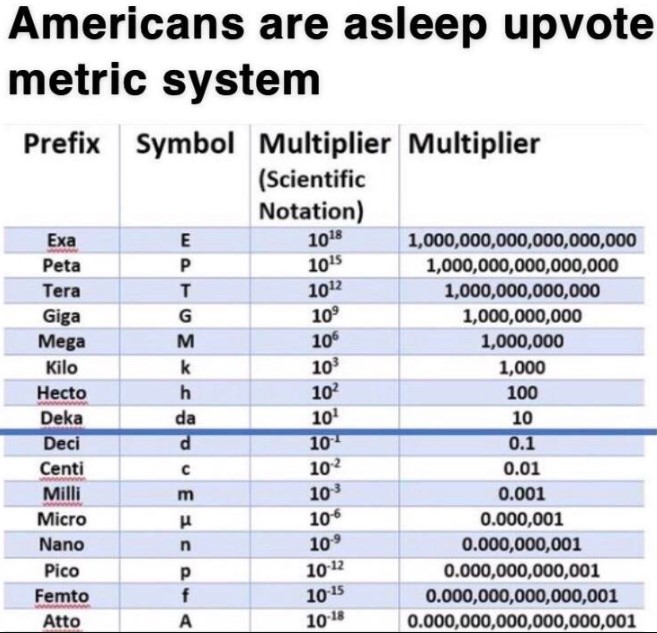this post was submitted on 31 Jul 2023
1509 points (97.5% liked)
Memes
45673 readers
737 users here now
Rules:
- Be civil and nice.
- Try not to excessively repost, as a rule of thumb, wait at least 2 months to do it if you have to.
founded 5 years ago
MODERATORS
you are viewing a single comment's thread
view the rest of the comments
view the rest of the comments

This is wrong. Some identifiers should start with a lowercase letter (like kilo)
I dislike how Atto breaks the "lowercase=small" convention with the capital A symbol.
Correct, except in Computing, there the Kilo, Mega, Giga ....are in uppercase, to differentiate it from the decimal system as it is based on powers of 2. 1 km is 1000 meters but 1 Kb is 1024 bytes
That is no correct. You are talking about kibi, mebi and gibi. The corresponding identifiers are Ki, Mi and Gi, not K M and G. K would mean Kelvin, M is 10⁶, G is 10⁹
You're both right, and that's the problem.
And it only gets more complicated from there.
In storage 1GB is 1000MB and 1MB is 1000KB and 1KB is 1000 bytes..... This is almost exclusive to hard drives. The rest of the industry uses what is now known as KiB, MiB and GiB, or kebibytes, mebibytes, and gibibytes. 1GiB is 1024MiB, and 1MiB is 1024KiB, and 1KiB is 1024 bytes.
If you're not talking about disk storage, then 1MB is 1MiB (1MB can be either 1024KB or 1000KB depending on context). The terms GiB/MiB/KiB were created because of the confusion between 1024 and 1000 for each jump in size, it's a relatively new term created to increase clarity between the various definitions, where MiB will always be the 1024 KiB version, and MB can be either; in this way, HDD manufacturers don't need to change anything that they are doing, and the industry can have a pure term, free of the confusion created by the disk drive industry.
To bake your brain even more, datacom uses 1000 instead of 1024 for increments, so 1Kbps is 1000bits/s and 1Mbps is 1000Kbits/s. So data transfer, link speeds and throughputs are generally going by the 10base numbering instead of the powers of 2.
The whole thing is a mess, and everyone wants to be the "will acktually" person to correct people about MB vs MiB and none of it actually matters, it's an entirely stupid situation created because the data storage jerks wanted to be able to put a slightly bigger number on their box to say how much capacity their drives had by just omitting the extra 24 bytes per KB, and extra 24 KB per MB, etc. So their product would look like it's bigger than it is.
Arguing about it is pointless.
It is not the result of inflating the data, but the consequence of the base 2 (binary system). 2^2 =4 2^3 = 8 ....16, 32, 64, 128, 256, 512, 1024 (1Kb), 2048, 4096, 8192, ......
I know of the new designations, but they are in my opinion unnecessary. It is true that K is the abbreviation for Kelvin, but in computing, if you don't use a liquid-cooled super game computer, it's clear to anyone that Kb has nothing to do with temperature.
The power of 2 version 2^10 or 1024, is indeed a result of the binary system, and since that's how computers work, that's what everyone used, but by listing a 1 billion byte disk as "1GB" instead of its actual, measured quantity, which, in gibibytes, I billion bytes is actually 953.67 MiB, companies can artificially inflate the perceived size of a disk, instead of buying a 953 MB disk, you're buying a 1GB disk and only getting 953 MiB as a result.
It makes the disk look larger than it is on paper and almost every newcomer to technology has questioned this at some point, and been disappointed that the x GB disk is nontrivially smaller than they expected.
It's a technicality that is disengenious, and creates confusion. All the disk makers had to do was conform to the same number of bytes per kB, and kBs per MB... Etc, that literally everyone else was using, but they wanted to deceive people about it, I guess. Make their marketing look better than the competition.... There's a few disk makers out there that are more or less reversing the trend, but the damage is done. It's why the MiB and GiB (etc) terms even exist.
K being 1024 only makes sense for RAM and ROM which are addressed with a particular number of address lines where the addressable size is 2^(number of address bits). Flash memory, and rotating media have entirely different addressing structures so normal SI units work bettor for them, and just about everything else.